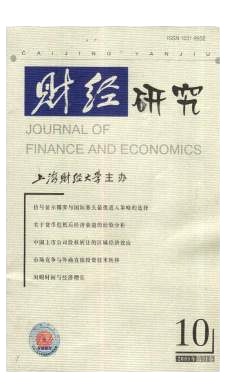市场竞争与外商直接投资技术转移——来自中国制造业的证据
财经研究 2005 年 第 31 卷第 10 期, 页码:66 - 78
摘要
参考文献
摘要
目前对技术溢出的研究较少关注“溢出源”,尤其是基于市场竞争视角和中国背景的经验研究。文章首先讨论了Wang-Blomstrom假说,进而借助“市场结构—技术创新”关系的研究成果提出“市场竞争—外资技术引进”关系的有关假说,并探讨了异于常规的、面向外资企业的“竞争”的定义和度量,最后基于中国制造业面板数据进行实证检验。实证检验结果表明,外资企业在东道国市场面临更大竞争会促进其增加技术引进,对于发展中东道国,需要具有一定规模和优势的企业而不是接近完全竞争的市场结构,才能提高外资企业面临的竞争程度。
[1]包群,赖明勇.FDI技术外溢的动态测算及原因解释[J].统计研究,2003,(6):33~38.
[2]何洁.外国直接投资对中国工业部门外溢效应的进一步精确量化[J].世界经济,2000,(12):29~36.
[3]江小涓.跨国投资、市场结构与外商投资企业的竞争行为[J].经济研究,2000,(9):31~38.
[4]刘小玄.中国转轨经济中的产权结构和市场结构—产业绩效水平的决定因素[J].经济研究,2003,(1):21~29.
[5]潘文卿.外商投资对中国工业部门的外溢效应:基于面板数据的分析[J].世界经济,2003,(6):3~7.
[6]熊彼特.资本主义、社会主义与民主[N].北京:商务印书馆,1999:99~105.
[7]杨蕙馨.中国企业的进入退出———1985~2000年汽车与电冰箱产业的案例研究[J].中国工业经济,2004,(3):99~105.
[8]Aghion P,Harris C,J Vickers.Competition and growth with step-by-step innovation:An example[J].European Economic Review,Papers and Proceedings,1997,(3):771~782.
[9]Aghion P,Harris C,Howitt P,J Vickers.Competition,imitation and growth with step-by-step innovation[J].Review of Economic Studies,2001,68,(3),467~492.
[10]Aghion P,P Howitt.A model of growth through creative destruction[J].Econometri-ca,1992,60:323~351.
[11]Aghion P,Bloom N,Blundell R.Competition and innovation:An inverted U relation-ship[R].NBER Working Paper 9269,USA,2002.
[12]Arrow K.Economic implications of learning by doing[J].Review of Economic Studies,1962,29,(80):12~28.
[13]Blomstrom M.A Kokko,et al.Host country competition,labour skills,and technologytransfer by multinationals[J].Weltwirtschaftliches Archiv,1994,128:522~533.
[14]Blomstrom M,A Kokko,et al.Host country competition and technology transfer bymultinational[R].NBER working paper,4131,USA,1992.
[15]Boone Jan.Competitive pressure:The effects on investments in product and process in-novation[J].Journal of Economics,2000,31(3):549~569.
[16]Caballero R,A Jaffe.How high are the giants’shoulders?An empirical assessment ofknowledge spillovers and creative destruction in a model of economic growth[M].NBERMacroeconomic Annual:15~74.
[17]Caves R E.International corporations:The industrial economics of foreign investment[J].Economica,1971,38:1~27.
[18]Caves R E.Multinational firms,competition and productivity in host country markets[J].Economica,1974,41:176~193.
[19]Campa J M,L S Goldberg.Investment in manufacturing,exchange rates and externalexposure[J].Journal of International Economics,1995,38(3~4):297~320.
[20]Cheung,Yin-Wong,M Chinn,E Fujii.Market structure and the persistence of sectoralreal exchange rates[J].International Journal of Finance and Economics,2001,6(2):95~114.
[21]Cheung,Yin-Wong,Antonio garcia Pascual.Market structure,technology spillovers,and persistence in productivity differentials[J].International Journal of Applied Eco-nomics,2004,(9):1~23.
[22]Dasgupta P,Stiglitz J.Industrial structure and the nature of innovative activity[J].E-conomic Journal,1980,90:266~293.
[23]Domowitz I,R G Hubbard,B C Peterson.Business cycles and the relationshio betweenconcentration and price-cost margins[J].Rand Journal of Economics,1986,17(1):1~17.
[24]Gerschenkron A.Economic Backwardness in Historical Perspective[M].Massachu-setts:Belknap Press of Harvard,1962.
[25]Kindleberger C P.Multinational Excursion[M].Cambridge:MIT Press,1984.
[26]Koizumi T,K J Kopecky.Economic growth,capital movements and the internationaltransfer of technical knowledge[J].Journal of International Economics,1977,(7):45~65.
[27]Kokko A.Foreign direct investment,host country characteristics,and spillovers[R].Stockholm,EFI-Stockholm School of Economics,1992.
[28]Kokko A,M Blomstrom.Policies to encourage inflows of technology through foreignmultinationals[J].World Development,1995,23(3):495~468.
[29]Kumar,Nagesh.Technology imports and local research and development in indianmanufacturing[J].The Developing Economies,1987,25:220~233.
[30]Nickels S.Competition and corporate performance[J].Journal of Political Economy,1996,104:724~746.
[31]Wang,J-Y,M Blomstrom.Foreign investment and technology transfer,a simple model[J].European Economic Review,1992,36(1):137~155.Market Competition and Foreign Direct InvestmentTechnology Transfer:Evidence fromChina’s Manufacture SectorsCHEN Yu(School of International Business Administration,Shanghai University of Finance and Economics,Shanghai200433,China)Abstract:The existent researches on technology(下转第136页)
①事实上,在国内还没有将“溢出源”与“吸收能力”划分为技术溢出效应中同等重要的对应体。
②Kokko提到了引进成本可能有向下的变化,但是没有纳入分析之中。
③参见Dasgupta和Stiglitz(1980)及第一代熊彼特增长模型(Aghion,Howitt,1992;Ca-ballero,Jaffe,1993)。
④如外资技术引进与总产值的相关性估计(RE模型):z值为0.35,Wald chi2(1)=0.12,p=0.7300。
⑤赫芬达指数为行业中所有企业市场占有率的平方和,因此存在着数据收集很大困难,实践中计算赫芬达指数几乎是不可能的。
⑥该法还可见于Nickell(1996)。
⑦采用此种方法的还有Domowitz等(1986);Campa和Goldberg(1995);Cheung等(2001)的研究。
⑧杨蕙馨(2004)对此有具体论述,参见参考文献[7]。
⑨对两个指标面板数据进行相关性估计(RE模型):系数为-.5703,z值为-3.99,Waldchi2(1)=15.92,p=0.0001。
⑩经检验发现外资比重与外资产值没有严格相关性(RE模型:z值为0.18,Wald chi2(1)=0.03,p=0.8553),前文指出外资产值与技术引进也不相关,所以可以认为外资比重与技术引进的关系是“市场竞争”在起作用。
11技术机会是由创新可能发生的技术范围和经济范围共同构成的,技术范围没有绝对极限,经济学一般分析经济范围:不同的产业、变化的市场需求结构、经济的景气程度、商业周期、社会投资的方向和规模、企业的资源及筹措资源的能力、创新的成本—效益比等等都从经济上决定着技术机会的大小(邓波等,2003);Stoneman认为技术机会与市场规模、市场份额以及价格上涨正相关,而与创新成本负相关;Kumar等则指出技术机会与行业技术成熟性、前沿技术差距、知识产权保护以及需求相关。
12外资企业技术引进的各项指标没有1999年以前的统计数据,因此面板数据被限制从1999年起。
13对两个指标面板数据进行相关性估计(RE模型):系数为0.2197,z值为4.79,Waldchi2(1)=22.94,p=0.0000。
[2]何洁.外国直接投资对中国工业部门外溢效应的进一步精确量化[J].世界经济,2000,(12):29~36.
[3]江小涓.跨国投资、市场结构与外商投资企业的竞争行为[J].经济研究,2000,(9):31~38.
[4]刘小玄.中国转轨经济中的产权结构和市场结构—产业绩效水平的决定因素[J].经济研究,2003,(1):21~29.
[5]潘文卿.外商投资对中国工业部门的外溢效应:基于面板数据的分析[J].世界经济,2003,(6):3~7.
[6]熊彼特.资本主义、社会主义与民主[N].北京:商务印书馆,1999:99~105.
[7]杨蕙馨.中国企业的进入退出———1985~2000年汽车与电冰箱产业的案例研究[J].中国工业经济,2004,(3):99~105.
[8]Aghion P,Harris C,J Vickers.Competition and growth with step-by-step innovation:An example[J].European Economic Review,Papers and Proceedings,1997,(3):771~782.
[9]Aghion P,Harris C,Howitt P,J Vickers.Competition,imitation and growth with step-by-step innovation[J].Review of Economic Studies,2001,68,(3),467~492.
[10]Aghion P,P Howitt.A model of growth through creative destruction[J].Econometri-ca,1992,60:323~351.
[11]Aghion P,Bloom N,Blundell R.Competition and innovation:An inverted U relation-ship[R].NBER Working Paper 9269,USA,2002.
[12]Arrow K.Economic implications of learning by doing[J].Review of Economic Studies,1962,29,(80):12~28.
[13]Blomstrom M.A Kokko,et al.Host country competition,labour skills,and technologytransfer by multinationals[J].Weltwirtschaftliches Archiv,1994,128:522~533.
[14]Blomstrom M,A Kokko,et al.Host country competition and technology transfer bymultinational[R].NBER working paper,4131,USA,1992.
[15]Boone Jan.Competitive pressure:The effects on investments in product and process in-novation[J].Journal of Economics,2000,31(3):549~569.
[16]Caballero R,A Jaffe.How high are the giants’shoulders?An empirical assessment ofknowledge spillovers and creative destruction in a model of economic growth[M].NBERMacroeconomic Annual:15~74.
[17]Caves R E.International corporations:The industrial economics of foreign investment[J].Economica,1971,38:1~27.
[18]Caves R E.Multinational firms,competition and productivity in host country markets[J].Economica,1974,41:176~193.
[19]Campa J M,L S Goldberg.Investment in manufacturing,exchange rates and externalexposure[J].Journal of International Economics,1995,38(3~4):297~320.
[20]Cheung,Yin-Wong,M Chinn,E Fujii.Market structure and the persistence of sectoralreal exchange rates[J].International Journal of Finance and Economics,2001,6(2):95~114.
[21]Cheung,Yin-Wong,Antonio garcia Pascual.Market structure,technology spillovers,and persistence in productivity differentials[J].International Journal of Applied Eco-nomics,2004,(9):1~23.
[22]Dasgupta P,Stiglitz J.Industrial structure and the nature of innovative activity[J].E-conomic Journal,1980,90:266~293.
[23]Domowitz I,R G Hubbard,B C Peterson.Business cycles and the relationshio betweenconcentration and price-cost margins[J].Rand Journal of Economics,1986,17(1):1~17.
[24]Gerschenkron A.Economic Backwardness in Historical Perspective[M].Massachu-setts:Belknap Press of Harvard,1962.
[25]Kindleberger C P.Multinational Excursion[M].Cambridge:MIT Press,1984.
[26]Koizumi T,K J Kopecky.Economic growth,capital movements and the internationaltransfer of technical knowledge[J].Journal of International Economics,1977,(7):45~65.
[27]Kokko A.Foreign direct investment,host country characteristics,and spillovers[R].Stockholm,EFI-Stockholm School of Economics,1992.
[28]Kokko A,M Blomstrom.Policies to encourage inflows of technology through foreignmultinationals[J].World Development,1995,23(3):495~468.
[29]Kumar,Nagesh.Technology imports and local research and development in indianmanufacturing[J].The Developing Economies,1987,25:220~233.
[30]Nickels S.Competition and corporate performance[J].Journal of Political Economy,1996,104:724~746.
[31]Wang,J-Y,M Blomstrom.Foreign investment and technology transfer,a simple model[J].European Economic Review,1992,36(1):137~155.Market Competition and Foreign Direct InvestmentTechnology Transfer:Evidence fromChina’s Manufacture SectorsCHEN Yu(School of International Business Administration,Shanghai University of Finance and Economics,Shanghai200433,China)Abstract:The existent researches on technology(下转第136页)
①事实上,在国内还没有将“溢出源”与“吸收能力”划分为技术溢出效应中同等重要的对应体。
②Kokko提到了引进成本可能有向下的变化,但是没有纳入分析之中。
③参见Dasgupta和Stiglitz(1980)及第一代熊彼特增长模型(Aghion,Howitt,1992;Ca-ballero,Jaffe,1993)。
④如外资技术引进与总产值的相关性估计(RE模型):z值为0.35,Wald chi2(1)=0.12,p=0.7300。
⑤赫芬达指数为行业中所有企业市场占有率的平方和,因此存在着数据收集很大困难,实践中计算赫芬达指数几乎是不可能的。
⑥该法还可见于Nickell(1996)。
⑦采用此种方法的还有Domowitz等(1986);Campa和Goldberg(1995);Cheung等(2001)的研究。
⑧杨蕙馨(2004)对此有具体论述,参见参考文献[7]。
⑨对两个指标面板数据进行相关性估计(RE模型):系数为-.5703,z值为-3.99,Waldchi2(1)=15.92,p=0.0001。
⑩经检验发现外资比重与外资产值没有严格相关性(RE模型:z值为0.18,Wald chi2(1)=0.03,p=0.8553),前文指出外资产值与技术引进也不相关,所以可以认为外资比重与技术引进的关系是“市场竞争”在起作用。
11技术机会是由创新可能发生的技术范围和经济范围共同构成的,技术范围没有绝对极限,经济学一般分析经济范围:不同的产业、变化的市场需求结构、经济的景气程度、商业周期、社会投资的方向和规模、企业的资源及筹措资源的能力、创新的成本—效益比等等都从经济上决定着技术机会的大小(邓波等,2003);Stoneman认为技术机会与市场规模、市场份额以及价格上涨正相关,而与创新成本负相关;Kumar等则指出技术机会与行业技术成熟性、前沿技术差距、知识产权保护以及需求相关。
12外资企业技术引进的各项指标没有1999年以前的统计数据,因此面板数据被限制从1999年起。
13对两个指标面板数据进行相关性估计(RE模型):系数为0.2197,z值为4.79,Waldchi2(1)=22.94,p=0.0000。
引用本文
陈羽. 市场竞争与外商直接投资技术转移——来自中国制造业的证据[J]. 财经研究, 2005, 31(10): 66–78.
导出参考文献,格式为:
下一篇:财政规模决定:一个经验模型





 6798
6798  5032
5032

